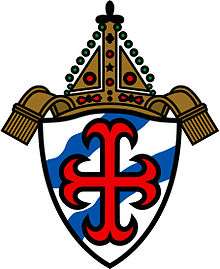Roman Catholic Diocese of Grand Rapids
The Roman Catholic Diocese of Grand Rapids (Latin: Dioecesis Grandcataractensis) is a diocese of the Roman Catholic Church in western Michigan, in the United States. It comprises 102 churches in 11 counties in West Michigan. It is a suffragan see to the Archdiocese of Detroit. The mother church of the diocese is the Cathedral of Saint Andrew. On April 18, 2013, Pope Francis accepted Bishop Walter A. Hurley's resignation and appointed the Rev. David J. Walkowiak to be the twelfth Bishop of Grand Rapids.
Diocese of Grand Rapids Dioecesis Grandcataractensis | |
|---|---|
Cathedral of St. Andrew | |
 | |
| Location | |
| Country | |
| Territory | Counties of Ottawa, Kent, Ionia, Muskegon, Newaygo, Oceana, Montcalm, Mecosta, Lake, Mason, and Osceola |
| Ecclesiastical province | Detroit |
| Statistics | |
| Area | 6,795 sq mi (17,600 km2) |
| Population - Total - Catholics | (as of 2006) 1,308,000 166,000 [1] (12.7%) |
| Parishes | 82 |
| Schools | 29 |
| Information | |
| Denomination | Catholic |
| Sui iuris church | Latin Church |
| Rite | Roman Rite |
| Established | May 19, 1882 (138 years ago) |
| Cathedral | Cathedral of Saint Andrew |
| Patron saint | St. Andrew |
| Secular priests | 110 |
| Current leadership | |
| Pope | Francis |
| Bishop | David J. Walkowiak |
| Metropolitan Archbishop | Allen Henry Vigneron |
| Vicar General | William H. Duncan |
| Bishops emeritus | Walter A. Hurley Robert John Rose |
| Map | |
 | |
| Website | |
| dioceseofgrandrapids.org | |
History
The diocese was created from territory taken from the Diocese of Detroit on May 19, 1882 by Pope Leo XIII. In 1938, it lost territory when Pope Pius XII established the Diocese of Saginaw. Further territory was lost in 1970 when Pope Paul VI created both the Diocese of Gaylord to its north and the Diocese of Kalamazoo to its south.[1][2]
The diocese's St. Adalbert Church in Grand Rapids became one of the less than seventy minor basilicas in the United States when Pope John Paul II raised it to that rank in 1979.[3]
Churches
Bishops
Bishops of Grand Rapids
- Henry J. Richter (1883–1916)
- Michael J. Gallagher (1916–1918), appointed Bishop of Detroit
- Edward D. Kelly (1919–1926)
- Joseph G. Pinten (1926–1940)
- Joseph C. Plagens (1941–1943)
- Francis J. Haas (1943–1953)
- Allen J. Babcock (1954–1969)
- Joseph M. Breitenbeck (1969–1989)
- Robert J. Rose (1989–2003)
- Kevin M. Britt (2003–2004)
- Walter A. Hurley (2005–2013)
- David J. Walkowiak (2013–present)
Coadjutor Bishops
- Michael J. Gallagher (1915-1916)
- Kevin M. Britt (2002-2003)
Auxiliary Bishops
- Joseph Schrembs (1911), appointed Bishop of Toledo and later Bishop of Cleveland
- Charles Salatka (1962-1968), appointed Bishop of Marquette and later Archbishop of Oklahoma City
- Joseph Crescent McKinney (1968-2001)
High schools
- Catholic Central High School, Grand Rapids
- Muskegon Catholic Central High School, Muskegon
- St. Patrick High School, Portland
- West Catholic High School, Grand Rapids
- Sacred Heart Academy Classical High School, Grand Rapids
See also
- Catholic Church by country
- Catholic Church hierarchy
- List of the Catholic dioceses of the United States
 |
Today, the Diocese of Grand Rapids encompasses the Catholic community in eleven counties in the mid-western part of Michigan's lower peninsula. This water image further underscores the defining presence of Lake Michigan, the western boundary of the Diocese of Grand Rapids, and in religious terms, the defining presence of Christ: "Jesus stood up and exclaimed, 'Let anyone who thirsts come to me and drink. Whoever believes in me, as scripture says: 'Rivers of living water will flow from within him.'" (John 7:37-38) Emblazoned over the watery background of the Coat of Arms of the Diocese of Grand Rapids is a red (Gules) Cross Moline, the arms of which peel off into two curls at the end. The word "moline" comes from the French moulin or "mill" since this cross resembles the curved extremities of a millrynd, the iron which supports an upper millstone. The agrarian roots of this cross shape suggest the wheat of the Holy Eucharist, the source and summit of the Christian community. While interpretations of the Cross Moline vary, some heraldic experts say that this particular Cross symbolizes the mutual convergence of human society – thus adding to its Eucharistic meaning. "As this broken bread was scattered upon the hills, and was gathered together and made one, so let thy Church be gathered together into thy kingdom from the ends of the earth." (Didache Apostolorum c.110 AD). In the context of the Diocese of Grand Rapids, the shape of the Cross Moline also has an extended symbolic meaning, which is an "anchor" firmly set in the water. The anchor is an image of Jesus Christ, the security of the soul, and a sign of hope in troubled waters: "...we who have taken refuge might be strongly encouraged to hold fast to the hope that lies before us. This we have as an anchor of the soul, sure and firm ...." (Hebrews 6:18-19) |
References
- "Diocese of Grand Rapids". Catholic-Hierarchy. Retrieved 2013-06-06.
- "Diocese of Grand Rapids". Giga Catholic. Retrieved 2013-06-06.
- "Basilica of St. Adalbert". GCatholic. Retrieved 2014-05-28.
External links
| Wikisource has the text of a 1913 Catholic Encyclopedia article about Diocese of Grand Rapids. |
- Roman Catholic Diocese of Grand Rapids Official Site
- Catholic Hierarchy: Diocese of Grand Rapids
- WOOD TV8: Hurley named Bishop of Grand Rapids
